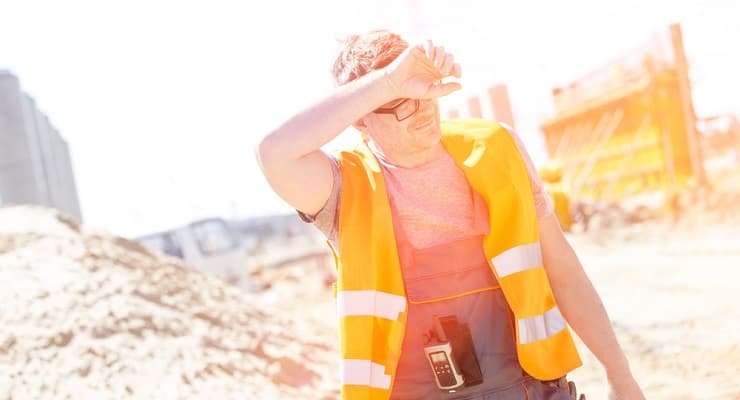At what temperature are you allowed to stop working?
WBGT Value
First of all, this: measuring how warm it is at your workplace is not done with a smartphone app or an ordinary thermometer. The only correct measurement method is a wet bulb globe thermometer. This device measures temperature, air velocity (wind, drafts), and humidity. These three factors together determine the WBGT value (Wet Bulb Globe Temperature). Often, the WBGT measurement result is lower than the temperature shown by a regular thermometer.
With extremely high humidity, for example 95%, the WBGT temperature roughly corresponds to what the ordinary thermometer indicates. This differs when humidity is lower. For instance, 30°C on a regular thermometer corresponds to:
-
22.7 WBGT at 35% humidity
-
25.4 WBGT at 55% humidity
-
28.2 WBGT at 80% humidity
Each category of work load has a corresponding WBGT value that determines when it becomes too hot to work safely:
Very heavy work: 18
Very heavy work involves very intensive physical effort such as heavy lifting, digging, climbing ladders and stairs… Examples of jobs in this category include dockworkers, miners, and steelworkers.
Heavy work: 22
Heavy work includes activities such as digging, hand sawing, planing, pushing and pulling wheelbarrows… Examples include construction workers, masons, carpenters, and other jobs in the construction sector.
Moderate work: 26
Moderate work includes occupations requiring physical effort but less intense than heavy work. Examples are warehouse workers, mail carriers, production workers, cleaners, kitchen staff, and gardeners.
Light work: 29
Light work covers jobs that require minimal physical effort or movement. Think of office workers, receptionists, cashiers, and similar roles.
Can you automatically stop working at these temperatures?
If the WBGT values for your work category are exceeded, this does not mean you are automatically exempt from work. The value does indicate, however, how much rest time you must take per hour:
|
Work Category
|
Work / Rest Ratio 1
|
Work / Rest Ratio 2
|
|
Very heavy work
|
45 minutes work – 15 minutes rest (WBGT 29)
|
30 minutes work – 15 minutes rest (WBGT 30)
|
|
Heavy work
|
45 minutes work – 15 minutes rest (WBGT 27)
|
30 minutes work – 15 minutes rest (WBGT 28)
|
|
Moderate work
|
45 minutes work – 15 minutes rest (WBGT 23)
|
30 minutes work – 15 minutes rest (WBGT 24)
|
|
Light work
|
45 minutes work – 15 minutes rest (WBGT 19)
|
30 minutes work – 15 minutes rest (WBGT 21)
|
Dangers of working during a heatwave
Just as very cold conditions can hinder work, working during a heatwave can be dangerous. The greatest risk is for people working outdoors or performing heavy physical labor. Think of sunburn, heatstroke, and dehydration. Working in warm weather can also lead to fatigue, resulting in reduced concentration and coordination, which in turn increases the chance of workplace accidents.
Tips for working in warm weather
If very warm weather is predicted, take the following precautions at work:
-
Drink enough water, at least 2 liters on a hot day. Tip: bring a cooler to always have fresh water nearby.
-
Take regular breaks in a cool or shaded environment. Maybe you can also create shade to perform your work? Be creative with sails, screens…
-
Wear light, breathable clothing that protects your skin from direct sunlight. A cap is a good idea, and don’t forget to apply sunscreen.
-
Adjust your work schedule. Avoid heavy exertion during the hottest part of the day and try to move those tasks to cooler times.
Employer obligations during warm weather
In Belgium, employers are required to take certain measures to protect workers’ health during very warm weather. The main ones are:
-
The employer must regularly measure the temperature at the workplace. When the temperature rises above threshold values, they must take measures to make the workplace more comfortable. Think of fans, air conditioning, and sunshades in offices, and shade cloths or sails for outdoor work.
-
The employer must grant extra rest breaks and adjust working hours, for example allowing employees to stop work earlier or start later to avoid the hottest hours.
-
Employers must provide free cool water and refreshing drinks to prevent dehydration.
-
Workers exposed to the sun must be provided with protective equipment such as caps, breathable clothing, and sunscreen.
Very high temperatures or a heatwave do not automatically mean you can stop working. It is important to measure temperature accurately and take the necessary precautions. If temperatures exceed threshold values and the measures taken are insufficient to guarantee a safe working environment, work can be temporarily suspended. Once the temperature returns to safe and tolerable levels, work can resume.
Let the beautiful summer come! Thanks to these tips, you can work comfortably and safely even when it is very hot.

